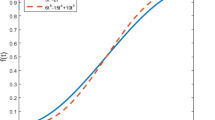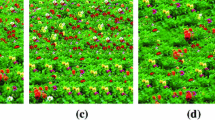Abstract
This paper presents an inexpensive method for self-similarity based editing of real-world 3D surface textures by using height and albedo maps. Unlike self-similarity based 2D texture editing approaches which only make changes to pixel color or intensity values, this technique also allows surface geometry and reflectance of the captured 3D surface textures to be edited and relit using illumination conditions and viewing angles that differ from those of the original. A single editing operation at a given location affects all similar areas and produces changes on all images of the sample rendered under different conditions. Since surface height and albedo maps can be used to describe seabed topography and geologic features, which play important roles in many oceanic processes, the proposed method can be effectively employed in applications regarding visualization and simulation of oceanic phenomena.
Similar content being viewed by others
References
Brooks, S., and N. A. Dodgson, 2002. Self-similarity based texture editing. ACM T. Graphic., 21(3): 653–656.
Chantler, M. J., 1995. Why illuminant direction is fundamental to texture analysis. IEE Proceedings: Vision, Image and Signal Processing, 142(4): 199–206.
Chapman, P., P. Stevens, D. Wills, and G. Brookes, 1998. Seabed Visualization. Ninth IEEE Visualization (VIS’98), 479 pp.
Dischler, J., and D. Ghazanfarpour, 1999. Interactive image-based modeling of macrostructured textures. Computer Graphics and Applications, IEEE, 19(1): 66–74.
Frankot, R. T., and R. Chellapa, 1988. A method for enforcing integrability in shape from shading algorithms. IEEE T. Pattern anal., 10(4): 439–451.
He, H., H. Liu, F. Zeng, and G. Yang, 2005. A Way to real-time ocean wave simulation. International Conference on Computer Graphics, Imaging and Visualization (CGIV’05), 409–415.
Nations, S., R. Moorhead, K. Gaither, S. Aukstakalnis, R. Vickery, et al., 1996. Interactive Visualization of Ocean Circulation Models. Seventh IEEE Visualization (VIS’96), 429 pp.
Rushmeier, H., G. Taubin, and A. Guezie, 1997. Applying shape from lighting variation to bump map capture. In: proceedings of the 8th eurographics rendering workshop, Saint-Etienne, France, 35–44.
Woodham, R., 1981. Analysing images of curved surfaces. Artif. Intell., 17: 117–140.
Author information
Authors and Affiliations
Corresponding author
Rights and permissions
About this article
Cite this article
Dong, J., Ren, J. & Chen, G. Self-similarity based editing of 3D surface textures using height and albedo maps. J Ocean Univ. China 6, 209–212 (2007). https://doi.org/10.1007/s11802-007-0209-0
Received:
Accepted:
Issue Date:
DOI: https://doi.org/10.1007/s11802-007-0209-0




